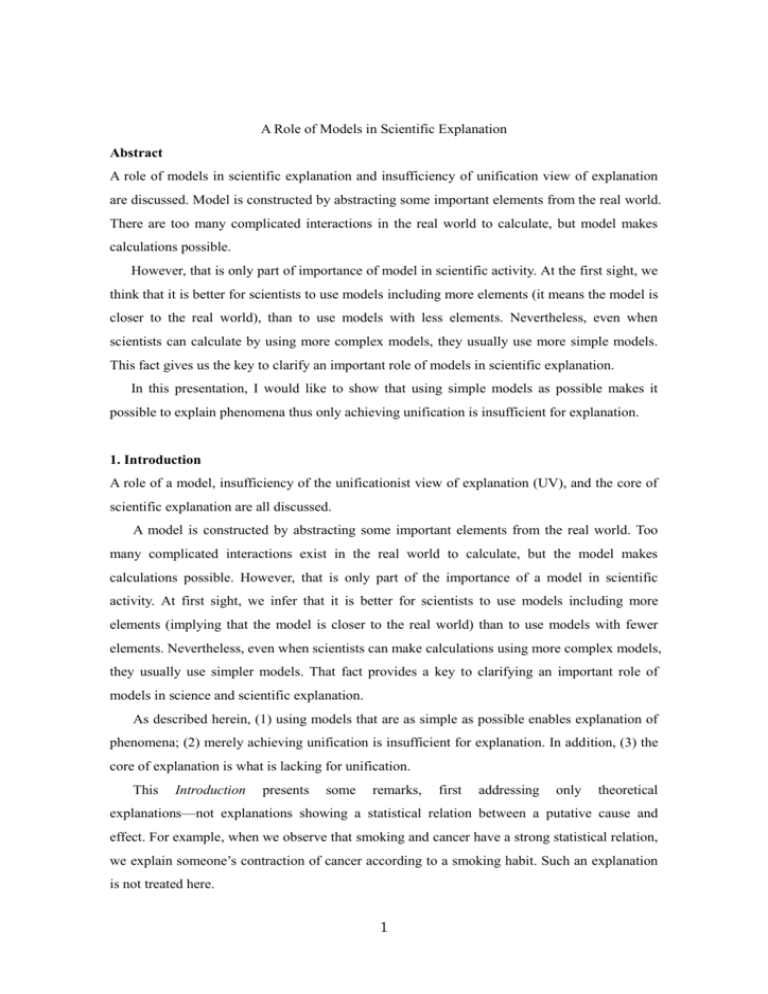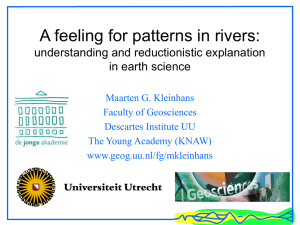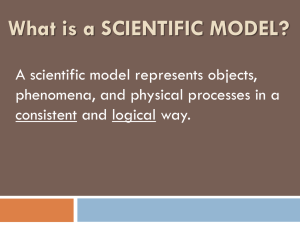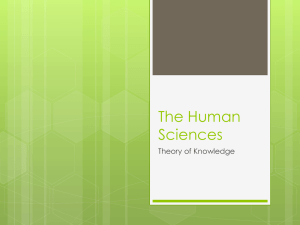A Role of Models in Scientific Explanation - PhilSci
advertisement

A Role of Models in Scientific Explanation Abstract A role of models in scientific explanation and insufficiency of unification view of explanation are discussed. Model is constructed by abstracting some important elements from the real world. There are too many complicated interactions in the real world to calculate, but model makes calculations possible. However, that is only part of importance of model in scientific activity. At the first sight, we think that it is better for scientists to use models including more elements (it means the model is closer to the real world), than to use models with less elements. Nevertheless, even when scientists can calculate by using more complex models, they usually use more simple models. This fact gives us the key to clarify an important role of models in scientific explanation. In this presentation, I would like to show that using simple models as possible makes it possible to explain phenomena thus only achieving unification is insufficient for explanation. 1. Introduction A role of a model, insufficiency of the unificationist view of explanation (UV), and the core of scientific explanation are all discussed. A model is constructed by abstracting some important elements from the real world. Too many complicated interactions exist in the real world to calculate, but the model makes calculations possible. However, that is only part of the importance of a model in scientific activity. At first sight, we infer that it is better for scientists to use models including more elements (implying that the model is closer to the real world) than to use models with fewer elements. Nevertheless, even when scientists can make calculations using more complex models, they usually use simpler models. That fact provides a key to clarifying an important role of models in science and scientific explanation. As described herein, (1) using models that are as simple as possible enables explanation of phenomena; (2) merely achieving unification is insufficient for explanation. In addition, (3) the core of explanation is what is lacking for unification. This Introduction presents some remarks, first addressing only theoretical explanations––not explanations showing a statistical relation between a putative cause and effect. For example, when we observe that smoking and cancer have a strong statistical relation, we explain someone’s contraction of cancer according to a smoking habit. Such an explanation is not treated here. 1 Second, a ‘model’ plays an important role in this article, but scientists use this term in various ways; they sometimes do not distinguish it clearly from ‘theory’. For convenience of discussion, a ‘model’ is an abstract system constructed by abstracting important elements––entities, fields, forces, and so on––from the real world. For instance, when deducing Kepler’s laws from Newtonian laws of motion and the Newtonian law of gravitation, we use a two-body model, which considers only the respective masses of two bodies (the Sun and the planet in question) and their distance, and which neglects other features such as color, size, and materials. Third, UV is insufficient. This view is originally proposed by Kitcher (1981) and he suggests that to explain is to reduce inference patterns. However, to adapt our discussion to this view, it is reinterpreted using the term ‘model’. The following reformulation does not spoil the essence of UV. Using the term ‘model’, unificationists insist that to explain is to construct a model that enables deduction of the explanandum from fundamental laws; thereby, scientists can reduce inference patterns. Unification of two types exists (see Fig. 1). Type 1: There is a set of fundamental laws, L1, such as Newtonian mechanics (NM). Presuming that some phenomena (or phenomenological laws) exist which are deduced from L1 using adequate models, there is a phenomenon, P, which has not been deduced from L1.1 If scientists find a model that makes it possible to deduce P from L1, we say that P is unified into L1, and that P is explained. For example, Uranus’ orbit was not deduced from NM until 1846. However, Leverrier and Adams succeeded independently in deducing the orbit from NM using a model in which an undiscovered planet (Neptune) was considered. Therefore, Uranus’ orbit was unified into NM, and it was explained. Type 2: No fundamental law exists from which phenomena P1, P2, P3, …, which are mutually independent, can be deduced. If scientists find a set of fundamental laws L2, and can deduce phenomena from L2 using adequate models, we say that P1, P2, P3, … are unified into L2. Then they are explained. Newtonian Synthesis is a typical example of unification of this type. Kepler’s laws and the Galileo’s law of falling bodies were thought to be mutually independent, but Newton succeeded in deducing them from NM. Then he used a two-body model to deduce Kepler’s laws. 2 2. Insufficiency of the Unificationist View of Explanation An important role of a model is to make calculation possible. The real world is too complicated to calculate. For that reason, we use a model whose elements are abstracted from the real world: “A model is a replica of the real world” (Suppe, 1989). However, we can presume a situation in which two models exist, M1 and M2, each of which is sufficiently simple for calculation, but M2 is more complicated and closer to the real world than M1. The question is: which is better for scientists to use for explanation? At first sight, because M2 provides a more exact solution related to the phenomenon in question than M1 (because M2 is closer to the real world), it seems better to use M2 for explanation, but complicated models (such as M2) often have no explanatory power, as explained below. Example 1. Assume that M1 is a two-body system, and that A, B, and C are planets in the solar system. Of them, A is closest to the sun, and C is most distant from the Sun. The latter is a 3 large planet such as Jupiter. Presume also a model M2, which is constructed by adding the gravitational pull of C to M1 (see Fig. 2). In short, M2 is a three-body model. In addition, presuming the following observational facts: the orbit of A obeys Kepler’s laws, but the orbit of B disobeys the Kepler’s laws. Furthermore, theoretically, M1 enables deduction of the orbit of A based on NM, but the orbit of B cannot be deduced from NM using M1. Furthermore, M2 enables deduction of both orbits of A and B based on NM. In this situation, how do scientists explain the irregular motion of B? Let us consider the following two patterns. Pattern 1. Step 1: Scientists construct a model M1 to deduce the orbit of A. Step 2: Scientists construct a model M2 to deduce the orbit of B. This pattern is normal. Intuitively, we think scientists can explain the irregular motion of B. However, consider pattern 2. Pattern 2. Step 1: Scientists construct a model M2 to deduce the orbit of A without constructing M1. Of course, M2 has the power to deduce the orbit of A (M2 includes the Sun, A and C). Step 2: Scientists construct a model M2 to deduce the orbit of B (M2 includes the Sun, B and C). Because they can deduce orbits of both A and B from NM using M2, according to UV, it is natural to conclude that M2 has the capability of explaining the orbit of B also in pattern 2. Furthermore, pattern 2 seems more eligible for explanation than pattern 1 because the same model M2 is applied to both A and B in pattern 2. Consequently, pattern 2 is more unificatory than pattern 1. However, why are scientists eager to explain B? They would like to explain what makes B disobedient of Kepler’s law despite A’s obedience. In other words, they seek what makes B 4 different from A. Nevertheless, because models used for deduction of A and B are the same one (M2), they cannot see what makes B different from A, meaning that scientists failed to explain the irregular motion of B although they succeeded in unifying the motion of B into NM in pattern 2. Therefore, merely achieving unification is not an explanation. This is a main conclusion of this paper. This problem arises not only when scientists construct M2 for deduction of A. Presume a model M3 that includes the Sun, A, B, and C (four-body model). Pattern 3. Step 1: Scientists construct a model M1 to deduce the orbit of A. Step 2: Scientists construct a model M3 to deduce the orbit of B. This pattern is also problematic because using M3 obscures the fact that C causes the irregular motion of B. Accordingly, scientists must use the simplest models that enable them to deduce the phenomenon in question. This is the second conclusion of this essay. One reason why the scientists require an explanation is that they would like to know why X, in contrast to the other members of the contrast-class (van Fraassen, 1980). In this example, scientists seek to understand why B disobeys Kepler’s law although the other planets obey it. Therefore, the core of the explanation is what makes X different from the other members. In this example, the core of explanation of the irregular motion of B is the gravitational pull from C, which makes B different from the other planets. To know what makes X different from the others, scientists must construct the simplest model. In fact, what is it that makes X different? What makes X different from the other phenomena is a difference between a new model that enables unification of X into the theoretical framework (like NM), and old ones that enable unification of the other phenomena into the framework. In our example, M1 is an old model and M2 is a new one, and their mutual difference is the gravitational pull from C. Consequently, the gravitational pull from C is the core of explanation of B’s disobedience to the Kepler’s laws, meaning that what makes X different is what was lacking to unify X. This is the third conclusion of this article, which is argued further in the following sections. 3. What is Lacking for Unification is not Always a Cause or What Makes it Different The previous section presented the conclusion with an explanation to show what makes X different, and that what makes X different is what was lacking for unification. Furthermore, in the example presented above, what makes X different is a cause of X. 5 Now, the following two questions arise. (1) Does “what makes X different” mean only a cause of X? (2) Is “what was lacking for unification” always equivalent to “what makes X different”? Both questions have negative answers. My analysis of the explanation presented in the preceding section is counterfactual. For instance, in the pattern 1, M1 has no capability to deduce the orbit of B, but M2 does. It follows that a counterfactual statement––“if we had not considered the contribution of gravitational pull from C, we would have been unable to have deduced the orbit of B”––is true. Lewis (1973) insists that a cause of an event e is an event without which event e would have not occurred. Consequently, our discussion seems to imply that to explain is to show a cause of an explanandum. However, as Kim (1973) says, in some cases, counterfactual dependence exists without causation. For example, a counterfactual––“if the chemical formula for water had not been H2O, water would not have had such character”––is true, but H2O is not a cause of water’s character (Achinstein, 1983). This example can be fitted into our discussion: the model is a system in which H2O is a chemical formula for water; it enables deduction of the distinct characteristics of water from quantum mechanics, but the other models do not enable such a deduction. Therefore, the core of explanation of distinct characteristics of water is to identify the chemical formula for water as H2O. The next question to answer is whether what was lacking for unification is always equal to what makes X different or not. I answer this question as negative; in some cases, the core of explanation of X is what was lacking for unification of X, but it is not what makes X different. For example, Dalton’s atomic theory makes it possible to unify the law of definite proportion and the law of mass conservation, which had been considered as mutually independent. This is a typical example of explanatory unification. The core of this explanation is atomic theory. However, atomic theory is neither a cause of these laws nor what makes them different. Still, the core of this explanation (atomic theory) is what was lacking for unification of these laws. To sum up, the core of explanation of X is what was lacking for unification of X, but what was lacking for unification of X is not always what makes X different (what makes X different is not always a cause of X). 4. Explanation without Laws Finally, at least one type of explanation does not need any fundamental law (Newton-Smith, 6 2000, pp. 128-9; Cartwright, 1983, pp. 51-2). In section 1, unification was classified into two types. However, both are unification into fundamental laws. Unification of another type can be suggested: no fundamental law exists, but a model exists that can uniformly reproduce characteristic features of a certain type of phenomenon in question. The word ‘reproduce’ is vague. Here, it means not only a case in which scientists mathematically or logically deduce phenomena expressed by propositions or mathematical forms (sometimes called law) but also a case in which the scientists numerically or visually reproduce the characteristic behavior of phenomena, for example using computer simulations (which are neither logical nor analytical). For instance, one can understand why the ‘small-world’ network (six degrees of separation) arises using a model (M1) in which clusters are mutually connected by long-distance interactions, or a model (M2) with some hubs having many interactions with other elements (Barabási, 2002; Watts & Strogatz, 1998). See Figs. 3a &3b. In this case, no fundamental law exists, but we can say that these phenomena are unified because the model described above can reproduce six degrees of separation. In this case, what is the core of explanation of the ‘small-world’ phenomenon? The reason 7 why this phenomenon is a problem to solve is that neither a model that has only short-distance interactions with each element nor a model that has only random interaction with each element can reproduce the six degree of separation (see Figs. 3c & 3d). Therefore, the core of the explanation is the existence of some long-distance interaction between clusters (M1) or the existence of hubs (M2). Notes 1. Hereinafter, the term ‘phenomenon’ is used to refer to both a phenomenon and phenomenological law. It is difficult to clarify what a phenomenon and phenomenological law are. However, their clarification is not necessary for this discussion. References Achinstein, P. (1983). The Nature of Explanation. (Oxford: Oxford UP). Barabási, A. (2002). LINKED: The New Science of Networks. (New York: Perseus Books). Cartwright, N. (1983). How the Laws of Physics Lie. (Oxford: Clarendon Press). Kim, J. (1973). Causes and Counterfactuals. Journal of Philosophy, 70, 570–572. Kitcher, P. (1981). Explanatory Unification. Philosophy of Science, 48, 507–531. Lewis, D. (1973). Causation. Journal of Philosophy, 70, 556–567. Newton-Smith, W. H. (2000). Explanation. (In: W. H. Newton-Smith (ed.), A Companion to the Philosophy of Science (pp. 127–133). Boston: Blackwell Publishers Inc.). Suppe, F. (1989). The Structure of Scientific Theories, 2nd ed. (Urbana & Chicago: University of Illinois Press). Van Fraassen, B. C. (1980). The Scientific Image. (Oxford: The Clarendon Press). Watts, D. J. & Strogatz, S. H. (1998). Collective Dynamics of “Small-World’ Networks. Nature, 393, 440–442. 8







